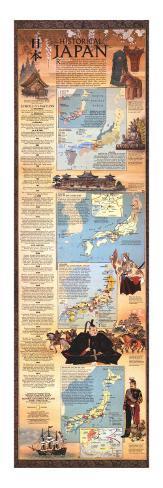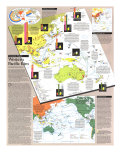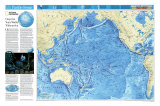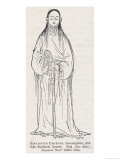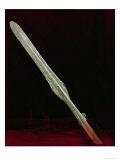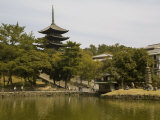* Lesson plan idea - have your students research archeological studies in Japan; discuss the political, economic, and environmental situations at time of publication and at date of their research. • maps
ROOTED IN A MYTHINCAL AGE when the sun goddess, Amaterasu, commanded her divine grandson to rule a land of “luxuriant rice fields,” Japan's history is that of an island people absorbed in their singular destiny, yet profoundly influenced by other cultures. Agriculture and technology, government, religion, writing, art – all owe much to the older civilizations of China and Korea, but each aspect underwent assimilation into styles uniquely Japanese. Throughout centuries of power struggles behind the throne, successive emperors reigned as symbolic fathers of a nation never occupied by foreign conquerors until 1945. The voices of this older Japan – of gods and heroes, priests, poets, and warriors – stil speak in the national psyche.
SCROLL OF A NATION -
STONE AGE AND ARCHAIC JAPAN - Rice-growing regions cradled a civilization that came to be dominated by aristocratic clan leaders of the central Yamato province, who founded the imperial line. Yamato became a name for ancient Japan.
30,000 B.C. - Earliest datable traces of human habitation; land bridges link Japan with Asian mainland.
ca 10,000 B.C. - Hunters and gatherers of the Jomaon culture thrive in small settlements. Their hand-formed pottery, decorated with word patterns, is among the earliest known in world.
ca 300 B.C. - Metalworking, the pottery wheel, and irrigated rice cultivation spread from Korea. This new culture, called the Yayoi, gradually replaces the Jomon; clan unites grow in power.
ca A.D. 300 - A 350-year tradition of great burial mounds for clan chieftains begins. The Yamato family gains supremacy by the sixth century and founds the imperial line that has never been broken.
552 - Buddhism arrives from China via Korea, one of many cultural borrowings. These include the use of Chinese characters for writing.
BIRTH OF A CENTRAL STATE - Far-reaching contacts with China and Korea introduced Buddhism, a faith soon adopted by the court. Reformers inspired by China's centralized government sought to strengthen court control over provincial clans. They established a bureaucracy to govern groups of provinces organized into circuits and linked by highways, declared imperial ownership of land, codified laws, and founded Nara as capital.
604 - Influenced by Buddhism and humanistic Confucianism, Prince Shotoku, regent to the Empress Suiko, drafts a document calling for ethical government and established a 200-year tradition of scholarly missions to China.
645 - Aiming for a central government based on the Chinese model, the Taika Reform abolishes most private landownership. The emperor grants plots to peasants during their lifetimes and taxes the harvests. The Taiho Code of 701 creates administrative offices and a legal system.
710 - Imperial court moves to the newly built city of Nara, Japan's first permanent capital and urban center. Chinese-inspired art and architecture flourish in imposing Buddhist temples as monasteries increase in the provinces. To escape Buddhist political influence, the court leaves Nara in 784.
AGE OF THE COURIERS - “China in miniature” describes the politics, architecture, and customs of the Nara period. Later art the court in Heian-kyo (Kyoto), innovations on Chinese themes created a lasting classic culture – a synthesis clearly and identifiably Japanese. Court life reached new heights of artistic pursuits and social complexity. Engrossed in luxury and intrigue, nobles ignored affairs in the provinces. Then, as imperial military and financial strength declined, private rural estates grew to provide a power base for an emerging warrior class. Court rivalries, backed by various provincial factions, led to the loss of imperial control during civil wars. Triumphant leaders of the Minamoto clan moved the seat of temporal power east to Kamakura, away from the figurehead court at Kyoto.
712 - Japan's first written history, the Kojiki, is followed by the nation's first anthology of poems, Collection of Myriad Leaves.
794 - The imperial court establishes Heian-kyo (Kyoto), “capital of peace and tranquillity.”
858 - The Fujiwara family secures rulling power as regents to the imperial throne.
ca 1000 - The Heian court bequeaths Japan a legacy of native artistic refinement. Courtiers devote themselves to calligraphy, poetry, and perfecting nuances in dress and etiquette – a world captured by Lady Murasaki Shikibu in the Tale of Genji, the world's first novel.
1156 - As the bureaucracy weakens through neglect, a military class emerges to manage porvincial affairs. A struggle for court control pits the Taira family against the Minamoto family. The Taira hold sway from 1160 to 1180.
1185 - The Minamoto clan triumphs ater a five-year war and in kamakura establishes the first military government. Power passes from the court aristocracy to the warrior class. The emperor names Minamoto Yoritomo as Japan's first shogun, or military ruler, in 1192, and his vassals serve as provincial administrators.
MEDIEVAL AND FEUDAL JAPAN - Throughout medieval centuries shoguns, or military governors, ruled with the emperor's mandate, but stablity was not achieved until a century of civil war ended in 1590. First contacts with Western nations came during this time, but they were severely restricted after Tokugawa shoguns gained mastery. The Tokugawa Shogunate classified vassal daimyos, or provincial lords, through kinship, hereditary status, or recent military alliance or conquest (outer daimyos). All were controlled from Edo (Tokyo). Society was rigidly stratified into samurai (warrior), peasant, artisan, and merchant classes. But with renewal of contacts with the outside world, the seeds of modernization were planted. After Western powers forced the opening of Japan's borders, the Tokugawa fell, and leaders of the Meiji Restoration seized the reins of power.
1191 - Zen Buddhism is introduced from China, and the warrior class gradually embraces its tenets of mental and physical discipline. From the 13th to 16th centuries, the Zen concept of beauty through restraint finds espression in No theater, rock gardens, ink painting, and flower arranging. Zen priests import tea as a stimulant to meditation and create the ritual tea service called cha-no-yu as a ceremony of spiritual renewal.
1274 and 1281 - Kublai Khan fails to add Japan to his Mongol Empire when storms – regarded by the Japanese as kamikaze, or divine winds – wreck his invasion fleets.
1336 - A power struggle leaves Japan with two imperial capitals for 60 years and a new shogunate, the Ashikaga, which lasts until 1573. Strong art patrons, the Ashikaga prove weak rulers. The Onin War, a civil conflict (1467-1477), devastates kyotot and heralds nearly a century of chronic civil strife.
1543 - Western commerce, guns, and Christianity arrive with Portuguese traders. St. Francis Xavier launches a Jesuit mission in 1549.
1560 - Military leader Oda Nobunaga works to unify the nation but is assassinated in 1582. Toyotomi Hideyoshi completes the campaign and in 1590 assumes control over the entire country. The torch passes in 1598 to Tokugawa Ieyasu, who crushes the last opposition in the Battle of Sekigahara in 1600.
1603 - The Tokugawa Shogunate begins a more than 250-year rule over a feudal society from the military capital Edo (Tokyo). By 1639 Japanese are forbidden to leave the country, missionaries have been expelled, Christian worship goes underground, and only Dutch and Chinese traders may visit one port, Nagasaki. In this isolation, haiku poetry and woodblock printing evolve, and a bougeois town culture patronizes geishas and Kabuki theater.
1720 - The ban on foreign books ends, and scholars absorb Dutch writings on science, medicine, and military skills. In the following century Western studes grow steadily, and foreigners seek trading privileges.
1853 - Commodore Matthew C. Perry sails into Tokyo Bay to force granting of American trading rights. Returning in 1854, he signs a treaty of friendship with the shoguns without imperial consent. American consul Townsend Harris arrives in 1856, and the Harris Treaty expands U.S. trade. Concessions with France, Great Britain, Russia, and the Netherlands follow.
1867 - Idealistic young samurai, advoctiong a return to imperial rule as a unifying force to prevent foreign domination, over throw the Tokugawa Shogunate and end feudalism.
MODERN JAPAN - Practical visionaries transformed a feudal, isolated nation into an industrialized international power in just half a century. United in nationalism embodied by the emperor, a highly organized, urban, widely skilled society adapted Western lessons quickly. The samurai as a class lost power with the beginning of parliamentary government and universal education. Great firms, called zaibatsu, traded with the world, while railroads and industrailized areas burgeoned. Foreign wars reaped an empire. When militarists gained control of the government in the 1930s, expansionist policies continued with events leading to World War II. Initial successes spread Japanese forces from the Bering Sea ot the Indian Ocean, but fortunes reversed. Before Japan's surrender in 1945, American bombers had laid waste every major city except Kyoto. Borders shrank to the home islands. The emperor remained the figurehead of a government recast along broader democratic lines.
1868 - Brought to power in the Meiji Restoration, Emperor Meiji oversees an era of rapid modernization from the new capital of Tokyo. Education reform achieves virtually complete literacy. After the creation of a conscript army, an imperial edict abolishes the samurai-class ranking. The last and greatest samurai revolt against the measure fails in 1877. Prime minister and cabinet are appointed in 1885, a constitution drafted in 1889, and a parliment, the Diet, elected in 1890. Victories in the Sino-Japanese War (1894-95) and Russo-Japanese War (1904-05) win overseas territory and signal Japan's emergence as a world power.
1931 - The Depression fuels the rise of nationalistic military leaders who occupy Manchuria and assassinate the prime minister. Japan goes to war with China in 1937 and in 1941 enters World War II against the United States, Great Britain, and the Netherlands.
1945 - Japan surrenders after the U.S. drops atom bombs on Hiroshima and Nagasaki. Allied forces occupy Japan until 1952 to guide government and economic reform. Women gain legal equality and first vote in 1946. Emperor Hirohito – whose reign began in 1926 and continues today – renounces claims to divinity but remains “a symbol of the state and of the unity of the poeple.”











